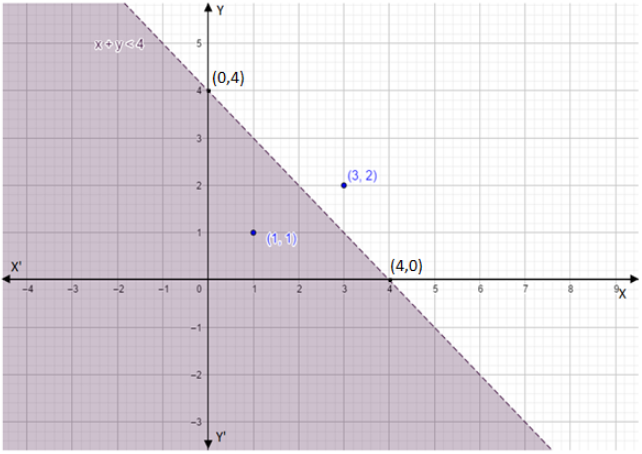
How do you graph the inequality \[x + y < 4\] ?
Answer
533.1k+ views
Hint: First we need to draw the graph of the equation \[x + y = 4\]. We use intercept form to draw the graph. That is we find the coordinate of the given equation lying on the line of x- axis, we can find this by substituting the value of ‘y’ is equal to zero (x-intercept). Similarly we can find the coordinate of the equation lying on the line of y- axis, we can find this by substituting the value of ‘x’ equal to zero (y-intercept). After drawing the graph we can check in which region the inequality satisfies.
Complete step by step answer:
Given, \[x + y < 4\]. Now consider \[x + y = 4\],to find the x-intercept. That is the value of ‘x’ at\[y = 0\]. Substituting this in the given equation. We have,
\[x + 0 = 4\]
\[ \Rightarrow x = 4\]
Thus we have a coordinate of the equation which lies on the line of x-axis. The coordinate is \[(4,0)\]. To find the y-intercept. That is the value of ‘y’ at \[x = 0\]. Substituting this in the given equation we have,
\[0 + y = 4\]
\[ \Rightarrow y = 4\]
Thus we have a coordinate of the equation which lies on the line of y-axis. The coordinate is \[(0,4)\]. Thus we have the coordinates \[(4,0)\] and \[(0,4)\]. Let’s plot a graph for these coordinates,we take scale x-axis= 1 unit = 1 units and y-axis= 1 unit = 1 units.

We expanded the point touching the intercepts. We took a coordinate above and below the equation of line (see in above graph). That is \[(x,y) = (3,2)\] and now put it in the inequality,
\[3 + 2 < 4\]
\[ \Rightarrow 5 < 4\]. Which is wrong.
Now take a coordinate below the equation of line,
That is \[(x,y) = (1,1)\]
\[1 + 1 < 4\]
\[ \Rightarrow 2 < 4\]. Which is true.
In the above graph the shaded region is the solution of the given inequality.
Note: If we take any coordinate point below the line of the graph, the inequality satisfies. Also if we take a point on the line, the inequality won’t be satisfied. A graph shows the relation between two variable quantities, it contains two axes perpendicular to each other namely the x-axis and the y-axis. Each variable is measured along one of the axes. In the question, we are given one linear equation containing two variables namely x and y, x is measured along the x-axis and y is measured along the y-axis while tracing the given equations.
Complete step by step answer:
Given, \[x + y < 4\]. Now consider \[x + y = 4\],to find the x-intercept. That is the value of ‘x’ at\[y = 0\]. Substituting this in the given equation. We have,
\[x + 0 = 4\]
\[ \Rightarrow x = 4\]
Thus we have a coordinate of the equation which lies on the line of x-axis. The coordinate is \[(4,0)\]. To find the y-intercept. That is the value of ‘y’ at \[x = 0\]. Substituting this in the given equation we have,
\[0 + y = 4\]
\[ \Rightarrow y = 4\]
Thus we have a coordinate of the equation which lies on the line of y-axis. The coordinate is \[(0,4)\]. Thus we have the coordinates \[(4,0)\] and \[(0,4)\]. Let’s plot a graph for these coordinates,we take scale x-axis= 1 unit = 1 units and y-axis= 1 unit = 1 units.

We expanded the point touching the intercepts. We took a coordinate above and below the equation of line (see in above graph). That is \[(x,y) = (3,2)\] and now put it in the inequality,
\[3 + 2 < 4\]
\[ \Rightarrow 5 < 4\]. Which is wrong.
Now take a coordinate below the equation of line,
That is \[(x,y) = (1,1)\]
\[1 + 1 < 4\]
\[ \Rightarrow 2 < 4\]. Which is true.
In the above graph the shaded region is the solution of the given inequality.
Note: If we take any coordinate point below the line of the graph, the inequality satisfies. Also if we take a point on the line, the inequality won’t be satisfied. A graph shows the relation between two variable quantities, it contains two axes perpendicular to each other namely the x-axis and the y-axis. Each variable is measured along one of the axes. In the question, we are given one linear equation containing two variables namely x and y, x is measured along the x-axis and y is measured along the y-axis while tracing the given equations.
Recently Updated Pages
Master Class 9 General Knowledge: Engaging Questions & Answers for Success

Master Class 9 English: Engaging Questions & Answers for Success

Master Class 9 Science: Engaging Questions & Answers for Success

Class 9 Question and Answer - Your Ultimate Solutions Guide

Basicity of sulphurous acid and sulphuric acid are

Master Class 12 Business Studies: Engaging Questions & Answers for Success

Trending doubts
Which places in India experience sunrise first and class 9 social science CBSE

Fill the blanks with the suitable prepositions 1 The class 9 english CBSE

Write the 6 fundamental rights of India and explain in detail

Difference Between Plant Cell and Animal Cell

What is pollution? How many types of pollution? Define it

What is the full form of pH?




